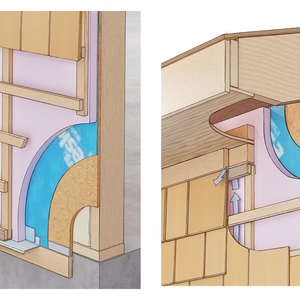One of my subs is recomending 4″ of sprayed in foam insulation for the cathedral ceilings with 2×12 rafters.He says that venting the roof is not necessary. Finished ceiling will be T&G pine. For the gables and dormer walls he says that 2″ to 2-1/2″ of foam is good. Home is located in southeast Michigan. I’m new to foam insulation, any experts out there?
Discussion Forum
Discussion Forum
Up Next
Video Shorts
Featured Story

Old masonry may look tough, but the wrong mortar can destroy it—here's how to choose the right mix for lasting repairs.
Highlights
"I have learned so much thanks to the searchable articles on the FHB website. I can confidently say that I expect to be a life-long subscriber." - M.K.
Fine Homebuilding Magazine
- Home Group
- Antique Trader
- Arts & Crafts Homes
- Bank Note Reporter
- Cabin Life
- Cuisine at Home
- Fine Gardening
- Fine Woodworking
- Green Building Advisor
- Garden Gate
- Horticulture
- Keep Craft Alive
- Log Home Living
- Military Trader/Vehicles
- Numismatic News
- Numismaster
- Old Cars Weekly
- Old House Journal
- Period Homes
- Popular Woodworking
- Script
- ShopNotes
- Sports Collectors Digest
- Threads
- Timber Home Living
- Traditional Building
- Woodsmith
- World Coin News
- Writer's Digest


















Replies
If you spray p/u foam directly to the underside of the roof sheating then it isn't required that you ventilate.
Gabe
Gabe, IRC2000 sez ALL roofs will be ventilated. Or, if there is a section somewhere that sez otherwise, I can't find it. Obviously foam on the sheathing eliminates the condensing surface and therefore any reason to vent, but the code sez "Thou shall vent"... Anyone know any different re this new code? Joe H
Joe,
I'm not familiar with your codes but most have mechanisms for special considerations. Obviously the code is refering to attic spaces and not systems.
If venting was an absolute in anyone's jurisdiction you could still satisfy the code by double sheating. First a 3/8, then strapping along the rafters and a regular sheating of 1/2 or 9/16 over it.
Seems like a waste of money but it would do the job.
All of our post and beam houses don't have ventilation when we foam and it's fine in the OBC.
If I was using FG or cels I would ventilate but not foam.
Gabe
being a roofer in Michigan I see two problems 1. condesation forming in the deck self 2. if you do have to ever replace a section of deck (not to suppose to happen but boy do we make alot moneydoing just that) how do reinsulate. have not had seen a lot sprayed in place insulation other than the junk that they try to sell as roof for flat roofs that seagulls like to carry off. still scares me.
SIPs are just sprayed in foam done at the factory, they are legal so it must be OK to do it on site. But hey wadda I know?
I don't understand your point 1.
And point 2 isn't a problem to reinsulate if it were ever to be required for whatever reason. You just insulate the backside of the drywall and overlap.
You should get out more.
Gabe
"Obviously the code is refering to attic spaces and not systems."
The code section in question reads "Enclosed attics and enclosed rafter spaces formed where ceiling are attached directly to the underside of roof rafters shall have cross ventilation for each seaparte space by ventilating openings..."
No exceptions given. The 2000 Residential Building Code applies where I am, and Joe is right.
This may not be the applicable code where the owner lives, but if it does, it is absolute.
No such thing as absolute when referring to the code.
I don't have a copy of your code in front of me to read but I bet you five milkbones that I can find an out or a mechanism for approval of foam insulation without ventilation.
Gabe
Gabe: I assume you do not vent with spray-on foam because the foam is such a good vapor barrier that water from humid indoor air can't get to the sheathing. (Nor can it get into the insulation as it can will with FG or cellulose). And I agree with all of that.
What about the heat lost though the insulation of an unvented roof? Do you feel that a membrane such as Water & Ice is sufficient to keep water from ice dams from getting through? I don't disagree with that perspective, I just don't feel comfortable enough with it.
Without ventilation, you will get ice dams (in my climate and yours), right? So there will be water backing up, above the eaves, at times during the year. Knowing there will be water under a bit of pressure trying to get through the roofing means (to me) I want something as leak proof as a boat. I've got a very tight house (0.07 air changes per hour) but the boats I build are much tighter (zero leakage). I spend a lot more labor, materials, and worry per square foot to acheive that in the boats than the roofer spends per square foot on the roof. Or should I use Water & Ice and some roofing nails on my boats and save a lot of time and epoxy?
Again, I'm not disagreeing with your no-vent scenerio, only a little nervous about relying on a single component for an important role.
David Thomas Overlooking Cook Inlet in Kenai, Alaska
Gabe, the code is the new IRC2000, International Residential Code 2000.
I don't know if any part of Canada has yet adopted it, and since you are in commercial you may not have to worry about it either way.
But, I have read it through several times looking for any mention of an exception to the venting and if it's there, it is well hidden. Which could be, it's full of little bits and pieces of stuff that seems to belong on some other page. It's definitely ignoring any possibility that venting is not always required or even the best solution. Joe H
Hi David,
A lot of ice dam problems are associated with inconsistencies in the building envelope.
By using an applied product that has the ability to seal very small crevices, the likelyhood of a breach of the envelope is minimal.
Sometimes the use of multiple products to achieve a proper seal opens the door to human failings and the failure of one of the components will breach the entire system.
Another reason that I like the use of foam is because it moves the plane of the insulation to the back of the wall system.
Nail penetrations from the drywall installation will not comprimise the envelope in the slightest.
We've been using foam in commercial for the past 30 odd years and the track record speaks for itself.
Gabe
On my own place, I vented AND used Water&Ice and it has worked great, even during weather and snowpack combinations that give others problems. But it would be very appealing to spray right onto the sheathing. It would save a lot of tedious cutting and fitting and drilling all those soffit vents!
I agree that foam towards the outside sheathing is nice in that the exterior siding nails have already gone in but the sheetrock screws/nails haven't yet.
David Thomas Overlooking Cook Inlet in Kenai, Alaska
Absolute, when refering to a code, any code is not the best term to use. This code has exceptions listed for most requirements but not this one. But again, it depends on the interpretation of the clerk in charge of enforcing the code. Sometimes that clerk has enough sense to know that all applications were not covered by a single, 3 sentence paragraph, sometimes they don't. 50/50 chance. Here, I have a good raport with the reviewers and we work things out. In other places, I have dealt with fence posts that have the authority to make decisions.
5 milkbones? You're on. Get a copy and take a look. BTW, what code applies where you work?
Ontario Building Code is the governing factor on all our projects.
I assume yours is the International Residential 2000?
Gabe
The city in which I work, Rockford, IL had adopetd the IBC/IRC 2000. The remainder of the county (Winnebago Co.) is still governed by BOCA 1996. As is typical in this country, codes vary from town to town, county to county and state to state, all with little empires that have their own little twists, just to keep things interesting.